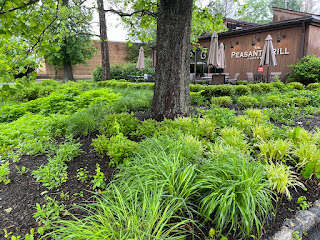Well, it finally happened. After five years of letting weeds get the upper hand, a maintenance crew declared defeat and tore most everything out of the raingarden next to the town fuel tank on Witherspoon Street.
The trajectory from first year splendor to decline and fall (see links below) is a familiar one. For thirty years, in three different towns and cities, I've been watching how complex landscape plantings prosper or decline. By complex, I mean any planting containing more than three intended species.
One could talk about how maintenance is undervalued in our society. People talk about planting a tree, but few talk about the followup care--the watering and weeding that determine whether that tree survives. Good maintenance is invisible. People notice when things go wrong, not when things are kept right. This is true whether it be a well maintained raingarden or a well-run government. Both go underappreciated, at their peril.
And we could talk about pervasive plant blindness--the scarcity of people who can distinguish one plant from another. We expect medical staff to be knowledgeable about the human body and its afflictions. A raingarden also requires expertise to keep it healthy. To weed with confidence, the landscape crew needs to be able to identify not only the intended plants but also the myriad weeds that invariably move in.
Here, in the foreground of this photo, you can see the main culprit. Though there are many other weeds, mugwort is the most aggressive non-native weed in a raingarden. Unchecked, it spreads quickly, soon leading to a sense of despair.
Also working against success is the typical scheduling used in a maintenance department. What if the two visits per year coincide with dry conditions? Weeding is best done when the ground has been softened by rain, and before the weeds have a chance to set seed. For a raingarden to be low-maintenance, intervention needs to be strategic and well-timed. That won't happen with a rigid schedule.
And sometimes I wonder, in this era of toxic masculinity when empathy is criticized as a weakness, whether a raingarden for some is too feminine, too complex or too hippie-like, and so ultimately yields to the masculine need to dominate with a mowing machine rather than nurture with a trowel. For whatever reason, the simplified, close-groomed look of a lawn tends to win out.
Turns out, though, that the fuel tank raingarden wasn't converted to turf out of frustration, but was instead replanted, probably at considerable cost. This suggests a commitment to maintaining the raingarden as a garden.
And yet, at the bottom of this photo, you can see the mugwort has not completely gone away.
Like our own immune systems, constantly quelling potential riots of pathogens lurking inside our bodies, a raingarden needs someone skilled in quelling the quiet riot of weeds lurking in the soil. With vigilance and timely intervention, the job gets easier and easier and the raingarden will flourish as originally intended. A skilled caretaker would spot these weeds and pull them out before they have a chance to gain momentum.
Just for comparison and to show what's possible, here is a thriving raingarden in Hopewell, in front of the Peasant Grill. It remains a low-maintenance, attractive planting year after year, surely because someone with knowledge acts quickly to pull weeds before they can get established. This is the informed, timely intervention we expect for ourselves in good medical care.
But even in that well-tended planting in Hopewell, a few pesky mugwort are ready to become many if there's no skilled caretaker to spot them quickly and pull them out. Sustaining peace, beauty, and harmony requires ongoing vigilance.
Another example is the
wet meadow I take care of at Smoyer Park--essentially a detention basin planted with native wildflowers and grasses. It is fed by runoff from the main parking lot.











